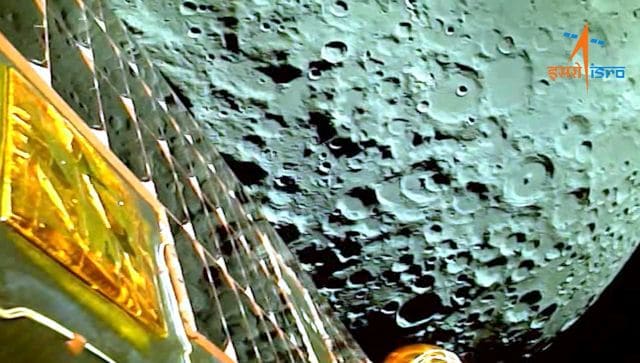Chandrayaan-3 to land on Moon on 23 August: What can we expect from now on?
India is reaching for the Moon. All eyes are now on Chandrayaan-3 as the landing date nears after Russia’s Luna-25 crashed onto the lunar surface.
Both India and Russia were racing for the Moon’s treacherous south pole, which has fascinated scientists for decades. Now India is likely to become the first country to land on the unexplored region, which is thought to contain water ice.
So how close is India to making history? And what can we expect in the days to come? We take a look.
Also read: Why Luna-25 crash-landed into the Moon and what it means for Russia
How has Chandrayaan-3’s journey been so far?
Chandrayaan-3, India’s third mission to the Moon, was launched successfully from Satish Dhawan Space Centre in Andhra Pradesh’s Sriharikota on 14 July. Weeks later on 5 August, the lander entered the lunar orbit.
It moved closer to the Moon on 20 August, after the Lander Module (LM) completed its final de-boosting operation. With this, the lander has reached an orbit where the closest point to the Moon is 25 km and the farthest is 134 km, the Indian Space Research Organisation (ISRO) informed on Sunday.

When will Chandrayaan-3 land on the Moon?
The lander is expected to touch the Moon’s surface on 23 August. “Chandrayaan-3 is set to land on the Moon on August 23, 2023, around 18:04 Hrs. IST,” ISRO announced through a tweet. “Thanks for the wishes and positivity!”
Chandrayaan-3 Mission:
🇮🇳Chandrayaan-3 is set to land on the moon 🌖on August 23, 2023, around 18:04 Hrs. IST.
Thanks for the wishes and positivity!
Let’s continue experiencing the journey together
as the action unfolds LIVE at:
ISRO Website https://t.co/osrHMk7MZL
YouTube… pic.twitter.com/zyu1sdVpoE— ISRO (@isro) August 20, 2023
It will land on the Moon’s coveted south pole.
What’s happening in the run-up to the climax?
ISRO has been giving regular updates about the anticipated landing. On Monday, it released pictures of the Vikram lander finding the landing sites ahead of the historic touchdown.
The latest photographs of the Moon reveal prominent craters on its far side, which faces away from the Earth. The images were taken by a camera, which is helping the lander zero in on finding a safe landing site – one which is without boulders or deep trenches.
“Here are the images of Lunar far side area captured by the Lander Hazard Detection and Avoidance Camera (LHDAC). This camera that assists in locating a safe landing area -- without boulders or deep trenches -- during the descent is developed at SAC/ISRO,” wrote ISRO on X, formerly known as Twitter.
Chandrayaan-3 Mission:
Here are the images of
Lunar far side area
captured by the
Lander Hazard Detection and Avoidance Camera (LHDAC).This camera that assists in locating a safe landing area -- without boulders or deep trenches -- during the descent is developed by ISRO… pic.twitter.com/rwWhrNFhHB
— ISRO (@isro) August 21, 2023
The images identified the craters Hayn, Boss L, Mare Humboldtianum, and Bel’kovich, reports NDTV.
Also read: Why the Moon’s south pole is so fascinating
What are the challenges ahead?
Space strategist P K Ghosh said that one of the “biggest” challenges in the landing of Chandrayaan-3 on the surface of the Moon is to get the spacecraft from a horizontal to a vertical position.
“One of the biggest things is that it has got to get the spacecraft from a horizontal position to a vertical position. That is difficult. All these aspects have to be looked into,” Ghosh was quoted by ANI as saying on Sunday.
Professor Annapurni Subramaniam, a senior astronomer and director of the Indian Institute of Astrophysics (IIA), Bengaluru, told News18 in an exclusive interview that Chandrayaan-3 will land on the surface of the Moon “without much of an issue”. “But it is the last 30 km that will be quite crucial.”

What are the chances of India’s success?
The astronomer is confident that India will achieve its goal. “ISRO has performed many manoeuvres from the launch till it reached the lunar orbit. Getting captured by the moon’s gravity was critical and we achieved that too. The mission has passed many critical steps. Now, the lander has to de-boost to a slightly lower orbit. This is yet another small but important step and we can definitely do it,” Subramaniam told News18.
What happens once Chandryaan-3 makes the landing?
Chandrayaan-3 is on a 14-day mission (one lunar day) on the lunar surface.
The three main objectives of the Moon mission are to demonstrate a safe and soft landing on the lunar surface, to demonstrate a rover landing on the moon, and to conduct in-situ scientific experiments.
After the spacecraft makes a landing, it will deploy a rover, called Pragyan, to explore the lunar surface using chemical and visual tests. The rover will collect data on the composition and geology of the moon.

The lander Vikram will deploy its four scientific payloads to study the moon’s surface temperature and subterranean characteristics. The module has an instrument called the ‘Spectro-polarimetry of Habitable Planet Earth’ (SHAPE), which will collect data about the light emitted and reflected by the Earth, according to a report in The Hindu.
Chandrayaan-3 will also conduct in-situ scientific experiments to study the lunar environment, such as its history, geology, and potential for resources.
The lander’s propulsion module will orbit the Moon to study the Earth’s atmosphere.
Where can you watch the Chandrayaan-3 landing?
The live telecast of the soft landing of Chandrayaan-3 will be available on the ISRO website, its YouTube channel, its Facebook page, and the DD National TV channel.
With inputs from agencies
from Firstpost India Latest News https://ift.tt/1CjX5lO
FP Explainers
Comments
Post a Comment